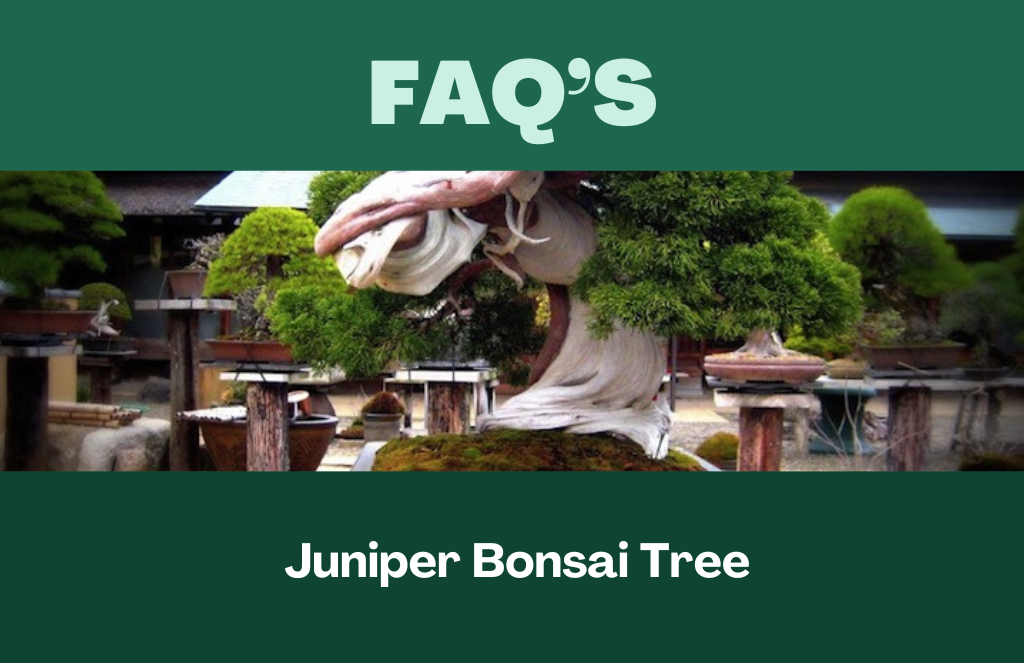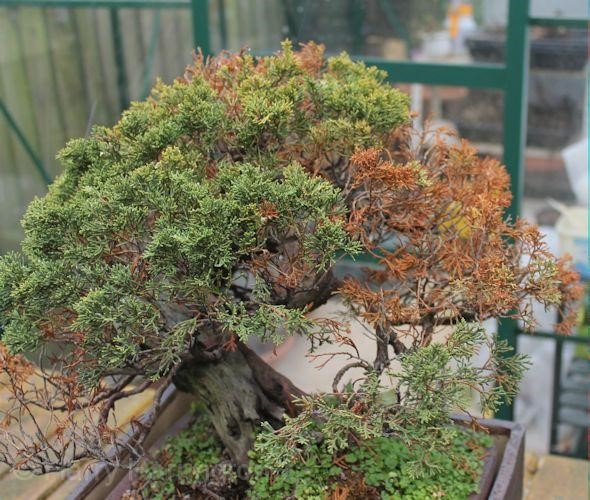Why is My Juniper Bonsai Tree Turning Brown?
The Juniper Bonsai tree is turning brown due to either over or under-watering insufficient light, or exposure to extreme temperatures. If your Juniper Bonsai tree is turning brown, it could be due to a few specific reasons.
One possible cause is over or under-watering – finding the right balance is crucial. Another factor to consider is the amount of light your Juniper Bonsai tree is receiving. Ensuring it has enough but not too much sunlight is important for its health.
Lastly, extreme temperatures can also cause browning. Understanding and addressing these factors will help you keep your Juniper Bonsai tree vibrant and green.
What Factors Affects The Juniper Bonsai Tree Health?
Juniper bonsai trees are known for their exquisite beauty and ability to bring a sense of tranquility to any space. However, it can be disheartening to see your beloved juniper bonsai tree turning brown. Several factors can contribute to the declining health of your juniper bonsai, including improper watering techniques, suboptimal sunlight conditions, and inadequate humidity levels.
Watering Technique
Watering plays a crucial role in the health and vitality of your juniper bonsai tree. Overwatering or underwatering can lead to the browning of foliage and eventual decline. To ensure proper watering, follow these techniques:
- Check the moisture level of the soil by inserting your finger about an inch deep into the soil. If it feels dry, it is time to water.
- Water the tree thoroughly, making sure the water reaches all parts of the soil.
- Avoid leaving the tree sitting in water, as it can cause root rot.
- Adjust the watering frequency based on the season and indoor/outdoor conditions.
Optimal Sunlight Requirements
Juniper bonsai trees thrive in bright sunlight, and insufficient light can adversely affect their health. Here are some guidelines to ensure optimal sunlight conditions for your juniper bonsai tree:
Place the tree in a location with direct sunlight for at least 6 hours a day.
Avoid exposing the tree to intense afternoon sunlight, as it can scorch the foliage.
Consider using artificial grow lights if you are unable to provide sufficient natural sunlight.
Right Humidity Level
Juniper bonsai trees require humidity levels between 50% and 80%. To maintain the right humidity levels, place a humidity tray filled with water near the tree, avoid placing the tree near air vents or drafts, and consider using a room humidifier.
Why Is My Juniper Bonsai Tree Browning?
If you have noticed that your once lush and vibrant juniper bonsai tree is turning brown, it can be a cause for concern. The browning of the foliage can indicate that something is amiss with your bonsai’s health. There are several common causes for this issue, and understanding them can help you identify the problem and take the necessary steps to revive your beloved juniper bonsai tree.
Overwatering
Overwatering is one of the primary causes of browning in juniper bonsai trees. When the roots are constantly soaked in water, it can lead to root rot, which in turn affects the tree’s ability to absorb nutrients.
The excess moisture causes the roots to suffocate and encourages the growth of harmful fungi and bacteria.
This lack of oxygen and the presence of pathogens weaken the tree’s root system, making it difficult for the bonsai to take up water and nutrients.
As a result, the foliage starts to turn brown and wilt. In severe cases, if not resolved promptly, overwatering can even lead to the death of the tree.
Underwatering
On the opposite end of the spectrum, underwatering is another common cause of browning in juniper bonsai trees. When a bonsai does not receive enough water, it goes into survival mode and starts conserving moisture by shedding its foliage.
The lack of water hampers the tree’s ability to carry out photosynthesis, causing the leaves to turn brown and dry out.
Underwatering can also result in stunted growth and make the tree more susceptible to pests and diseases. It is important to strike a balance and ensure that your juniper bonsai receives adequate water to maintain its health and vitality.
Soil-related Issues
The quality and condition of the soil in which your juniper bonsai tree is planted can play a significant role in its overall health. Soil-related issues can cause browning in the foliage, and it is crucial to address them to restore your bonsai’s vibrant appearance.
One common soil-related issue is poor drainage. If the soil becomes compacted or does not drain well, excess water can accumulate around the roots, leading to root rot and browning of the foliage. Ensuring that the soil is well-draining and using a bonsai-specific soil mix can help alleviate this problem.
Another issue is the lack of appropriate nutrients in the soil. Juniper bonsai trees require a well-balanced fertilizer regimen to thrive. Insufficient nutrients can cause the foliage to turn brown and become sickly.
How To Identifying And Addressing Pests And Diseases?
When it comes to keeping your Juniper Bonsai tree healthy and thriving, it’s essential to be familiar with the pests and diseases that can potentially harm it. By identifying and addressing these issues promptly, you can save your bonsai from further damage and ensure its longevity.
Common Pests And Symptoms
Juniper Bonsai trees are vulnerable to a variety of pests that can infest their foliage, branches, and roots. It is crucial to be able to identify these pests and their symptoms in order to detect and treat them early. Here are some common pests that may affect your Juniper Bonsai tree:
| Pest | Symptoms |
| Aphids | -Presence of small, green insects on leaves
– Sticky residue (honeydew) on leaves, branches, and soil |
| Spider Mites | – Fine webbing on the underside of leaves
– Yellowing and stippling of leaves – Leaves may become distorted and fall off |
| Scale Insects | – Small, circular or oval-shaped bumps on stems and foliage
– Yellowing and wilting of leaves – Sticky residue on leaves and branches |
| Vine Weevils | – Notched or irregularly shaped edges on leaves
– Presence of small, white larvae in the soil – Wilting or stunted growth |
How To Prevent And Treat Pest Infestations?
Preventing and treating pest infestations in your Juniper Bonsai tree is crucial for its overall health and appearance. By following these effective methods, you can maintain a pest-free bonsai:
Regular inspection: Frequently examine your bonsai’s foliage for signs of pests or damage.
Pruning: Remove and dispose of any infested branches or leaves to prevent the spread of pests.
Natural predators: Encourage beneficial insects such as ladybugs or lacewings, which feed on common bonsai pests.
Neem oil: Apply a diluted solution of neem oil to the foliage to deter and eliminate pests. Follow the instructions carefully.
Quarantine: When introducing new bonsai to your collection, isolate them for a few weeks to prevent potential pest spread.
Other Common Diseases That Cause Browning In Juniper Bonsai Trees And Their Symptoms
In addition to pests, Juniper Bonsai trees can also fall prey to various diseases, leading to browning or discoloration of their foliage. Here are some common diseases that may affect your bonsai:
- Cedar-apple rust: Yellow-orange rust spots on foliage, followed by browning and defoliation.
- Phomopsis blight: Browning and dieback of branch tips, accompanied by black fungal fruiting bodies.
- Root rot: Wilting, yellowing, and eventual browning of foliage, accompanied by foul odor and decayed roots.
- Needle cast: Browning and premature shedding of needles, typically starting from the inner canopy.
If you suspect your Juniper Bonsai tree is affected by any of these diseases, it is essential to take immediate action to prevent further decline.
Frequently Asked Questions

Why Is My Juniper Bonsai Tree Turning Brown?
Bonsai trees turning brown can be due to several reasons. One common cause is overwatering, which leads to root rot. Another reason could be under-watering or inadequate sunlight. Pests, diseases, or even wrong soil composition can also cause browning. It’s essential to identify the root cause and take appropriate measures to revive your Juniper Bonsai Tree.
Are there specific light requirements for Juniper bonsai trees?
Junipers thrive in full sunlight. If your bonsai is not receiving enough light, it may lead to browning foliage. Ensure it gets at least 4-6 hours of direct sunlight daily.
Can pests be a reason for browning in Juniper bonsai trees?
Yes, pests like spider mites or scale insects can cause browning. Inspect your bonsai regularly for any signs of pests and treat accordingly.
Should I prune the brown foliage on my Juniper bonsai?
Pruning can be beneficial to remove dead or brown foliage. Use clean, sharp scissors to trim affected areas, promoting overall health and aesthetics.
Conclusion
If your juniper bonsai tree is turning brown, it may be due to a few factors. Improper watering, lack of sunlight, nutrient deficiency, or pests could be the culprits. It’s crucial to closely analyze and address these issues promptly to revive the health and beauty of your tree.

